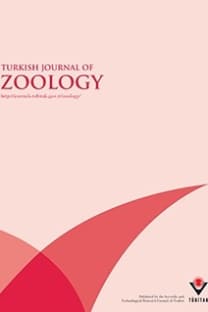Time-activity budgets of wintering Ferruginous Duck, Aythya nyroca, at Gajoldoba wetland, Jalpaiguri, India
Ferruginous Duck, time-activity budget, Gajoldoba wintering ground,
___
- Aissaoui R, Tahar A, Saheb M, Guergueb L, Houhamdi M (2011). Diurnal behaviour of Ferruginous Duck Aythya nyroca wintering at the El-Kala wetlands (Northeast Algeria). Bulletin de l’Institut Scientifique, Rabat, section Sciences de la Vie 33: 67–75.
- Ali S, Ripley SD (1978). Handbook of the Birds of India and Pakistan: Together with those of Bangladesh, Nepal, Bhutan and Sri Lanka. Delhi, India: Oxford University Press.
- Altmann J (1974). Observational study of behaviour: sampling methods. Behaviour 49: 227–267.
- Azafzaf H (2003). The Ferruginous Duck in Tunisia. In: Petkov N, Hughes B, Gallo-Orsi U, editors. Ferruginous Duck: From Research to Conservation. Sofia, Bulgaria: Birdlife International, RSPB, and TWSG, pp. 84–87.
- Baldassarre GA, Paulus SL, Tamisier A, Titman DRD (1988). Workshop summary techniques for timing activity of wintering waterfowl. In: Weller MW, editor. Waterfowl in Winter. Minneapolis, MN, USA: University of Minnesota Press, p. 23.
- BirdLife International (2001). Threatened Birds of Asia: The BirdLife International Red Data Book. Cambridge, UK: BirdLife International.
- del Hoyo J, Elliot A, Sargatal J (1992). Handbook of the Birds of the World, Volume 1: Ostrich to Ducks. Barcelona, Spain: Lynx Edicions.
- Green AJ (1998). Habitat selection by the Marbled Teal Marmaronetta angustirostris, Ferruginous duck Aythya nyroca and other ducks in the Göksu Delta, Turkey, in summer. Revue Ecologie (Terre and Vie) 53: 225–243.
- Green AJ, Fox AD, Hughes B, Hilton GM (1999). Time-activity budgets and site selection of White-headed Ducks Oxyura leucocephala at Burdur Lake, Turkey in late winter. Bird Study 46: 62–73.
- Hamilton AJ, Taylor IR, Hepworth G (2002). Activity budgets of waterfowl (Anatidae) on a waste-stabilization pond. Emu 102: 171–179.
- Hill DA, Ellis N (1984). Survival and age related changes in the foraging behaviour and time budget of Tufted Ducklings Aythya fuligula. Ibis 126: 544–550.
- Hohman WL, Rave DP (1990). Diurnal time activity budgets of wintering canvasbacks in Louisiana. Wilson Bull 102: 645–654.
- Houhamdi M, Samraoui B (2003). Diurnal behaviour of wintering Wigeon Anas penelope at Lac des Oiseaux, northeast Algeria. Wildfowl 54: 51–62.
- Houhamdi M, Samraoui B (2008). Diurnal and nocturnal behavior of Ferruginous Duck Aythya nyroca at Lac Des Oiseaux, Northern Algeria. Ardeola 55: 59–69.
- Islam ZU (2003). Ferruginous Duck in India. In: Petkov N, Hughes B, Gallo-Orsi U, editors. Ferruginous Duck: From Research to Conservation. Sofia, Bulgaria: Birdlife International, RSPB, and TWSG, pp. 104–113.
- Jeske CW, Percival HF (1995). Time and energy budgets of wintering Ring-necked Ducks Aythya collaris in Florida, USA. Wildfowl 46:109–118.
- Jorde DG, Owen RB (1988). The need for nocturnal activity and energy budgets of waterfowl. In: Weller MW, editor. Waterfowl in Winter. Minneapolis, MN, USA: University of Minnesota Press, pp. 169–180.
- Losito MP, Mirarchi E, Baldassarre GA (1989). New techniques for time activity studies of avian flocks in view-restricted habitats. J Field Ornithol 60: 388–396.
- McNeil R, Drapeau P, Goss-Custard JD (1992). The occurrence and adaptive significance of nocturnal habits in waterfowl. Biol Review 67: 381–419.
- Muzaffar SB (2004). Diurnal time-activity budgets in wintering Ferruginous Pochard Aythya nyroca in Tanguar Haor, Bangladesh. Forktail 20: 17–19.
- Paulus SL (1988). Time-activity budgets of nonbreeding Anatidae: a review. In: Weller MW, editor. Waterfowl in Winter. Minneapolis, MN, USA: University of Minnesota Press, pp. 135–152.
- Petkov N (2003). Ferruginous Duck habitat characteristics and daily activity rhythm in Bulgaria. In: Petkov N, Hughes B, Galb-Orsi U, editors. Ferrugionous Duck: From Research to Conservation. Sofia, Bulgaria: Birdlife International, BSPB, and TWSG, pp. 122–130.
- Poyni JE (1994). Abundance and feeding of wintering and migrating aquatic birds in two sampling areas of Lake Balaton in 1983– 1985. Hydrobiologia 279: 63–69.
- Rave DP, Baldassarre GA (1989). Activity budget of Green-Winged Teal wintering in costal wetlands of Louisiana. J Wild Management 53: 753–759.
- Robinson JA (2003). A global overview of the ecology of the Ferruginous Duck. In: Petkov N, Hughes B, Gallo-Orsi U, editors. Ferruginous Duck: From Research to Conservation. Sofia, Bulgaria: Birdlife International, BSPB, and TWSG, pp. 114–121.
- Robinson JA, Hughes B (2003). The global status and distribution of the Ferruginous Duck. In: Petkov N, Hughes B, Gallo-Orsi U, editors. Ferruginous Duck: From Research to Conservation. Sofia, Bulgaria: Birdlife International, BSPB, and TWSG, pp. 8–17.
- Rodway MS (1998). Activity patterns, diet and feeding efficiency of Harlequin Ducks breeding in northern Labrador. Cana J Zool 76: 902–909.
- Tamisier A (1974). Etho-ecological studies of teal wintering in the Camargue (Rhone Delta, France). Wildfowl 25: 107–117.
- Tucakov M (2005). Migration of common pochard Aythya ferina and ferruginous duck Aythya nyroca on Kolut Fishpond (Northern Serbia). Aquila 112: 15–22.
- ISSN: 1300-0179
- Yayın Aralığı: Yılda 6 Sayı
- Yayıncı: TÜBİTAK
Rotifers of southwest Iran: a faunistic and biogeographical study
Raheleh REIHAN RESHTEH, Hassan RAHIMIAN
Phoretic mites in uni- and bivoltine populations of Ips typographus: a 1-year case study
Melek ZEYBEK, Hasan KALYONCU, Büşra KARAKAŞ, Seda ÖZGÜL
Contribution to the knowledge of the Scutelleridae (Hemiptera, Heteroptera) fauna of Turkey
Erol YILDIRIM, Gülten YAZICI, Nihal KARAKURT
Şule SÜLÜN, Sercan BAŞKURT, Özgür EMİROĞLU, Daniela GIANNETTO, Ali Serhan TARKAN
Shuai HUANG, Lian LI, Jie WU, Chengmin LI, Jingyan BAI, Yu SUN, Genlin WANG
The jumping plant-lice (Hemiptera: Psylloidea) of Turkey: a checklist and new records
Jowita DROHOJOWSKA, Daniel BURCKHARDT
New data about ptyctimous mites (Acari, Oribatida) in Polish palm houses
